With the 24-year late global release of Romancing SaGa 3, the upcoming releases of SaGa: Scarlet Grace and Romancing SaGa Re;univerSe, and Romancing SaGa 2's global release two years ago, SquareEnix either seems to have rekindled a love for the SaGa franchise or Akitoshi Kawazu has built up enough good will in the company again to make another push for the series. In that light, I'd like to take the opportunity to provide people with their path into the wonderful world of SaGa for those willing to take the plunge into the crazy but stunning worlds that Kawazu and company have created through one of SquareEnix's longest running yet most misunderstood franchises. A franchise that has actually been a part of some pretty key moments for Square and the RPG genre as a whole is definitely something worth paying attention to.
After all, SaGa effectively provided Square with its second big success as a demonstration that Final Fantasy wasn't just their only successful franchise. SaGa showed that Square could do just as well on portables as they could on consoles, which also helped give the fledgeling Game Boy a bit of legitimacy by being one of the earliest meaty console like experiences you could play on the go. It also played a small role in showing Americans what RPGs could be, by coming out in the US mere weeks after the US launch of Final Fantasy on the NES. It was also the sophmore experience for a lot of new RPG fans in the time after both Final Fantasy 7 and Pokemon drew attention back to the genre, both by being one of Square's notable PS1 releases to follow FF7 in the US and by the reissues of the Game Boy games being released right at the right time to ride the waves of both.
Key People to Note:
Akitoshi Kawazu
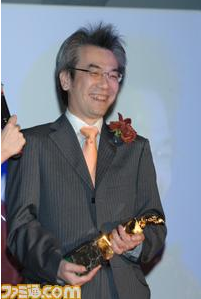

When people think of the core team behind the early years of Final Fantasy, typically the discussion defaults to Sakaguchi, Uematsu, Amano, and maaaaaaaybe Nasir (it's hard to ignore the big ol' name on the title screens). While each of these guys all played very major roles in the creation of the games, Akitoshi Kawazu was right there from the very beginning of that franchise playing a major role in a lot of key parts of Final Fantasy that are still standards to the franchise today. A lover of D&D and other classic tabletop roleplaying experiences, Kawazu has spent his career trying to find ways to incorporate different elements of the roleplaying into the JRPG. Love or hate his interpretations for how to go about doing that, it's hard to deny the man's utter passion for his vision. Unlike a lot his fellow early Square alums, Kawazu has been a lifer at Square/SquareEnix, which is partially what gives him the clout to keep this quirky series going.
Tomomi Kobayashi

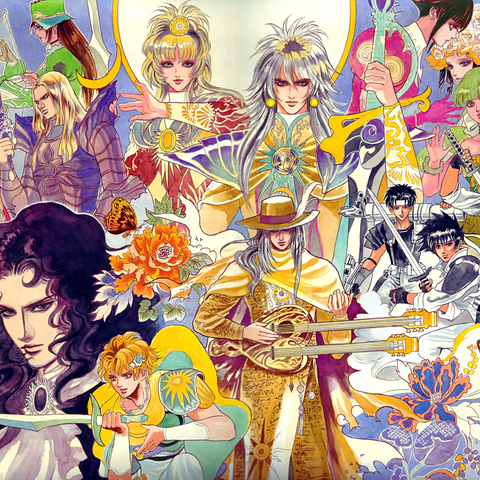
Every game needs a distinct visual style to help it pop for players, and Tomomi Kobayashi is the secret sauce for SaGa's stunning and recognizable visual style that still sets the SaGa games apart from a lot of Square's other work. Starting from her first work for the series in Romancing SaGa 1, Kobayashi has been just as much of an integral part of the SaGa experience as anyone else. Since she's become involved with the series, the worlds and characters of the SaGa games have taken on an utterly fantastic style that really speaks to the tone of the games. You can find her official site here.
Kenji Ito
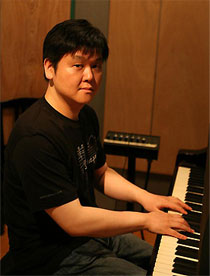
While Nobou Uematsu was the composer for the original game and thus defined a lot of the early sound of the franchise, Kenji Ito was brought in to co-compose the sequel with Uematsu before taking over the reigns as sole composer for the fourth through seventh game in the series. He has had just as much of an effect on defining the audio standards for the series. Though Ito stepped away for a few games, he's since returned to composing the remakes and the most recent new game in the series, Scarlet Grace. You also probably know Ito from composing several of the Mana games
Masashi Hamauzu:


The other major musical figure behind the series is Masashi Hamauzu, an exceedingly talented musician trained by his classical pianist mother and his opera singer father. Despite honestly being overqualified for the industry, Hamauzu loved video games and what Square was doing at the time and got a job composing for the RPG juggernaut, cutting his teeth on co-composing Front Mission: Gun Hazard and providing vocals for friggin' One Winged Angel. Stepping in for Ito, Hamauzu would compose the music for SaGa Frontier 2 (still one of the most amazing soundtracks in a video game to date) and Unlimited Saga, while also stepping in to co-compose FF10's soundtrack and eventually take the reigns on FFXIII. He has since left SquareEnix and hasn't worked on SaGa itself since, but has lately taken to composing the soundtracks for FuRyu's SaGa spiritual successors, Legacy of Legend and Alliance Alive.
Yusuke Naora

Starting with the PS2 games, Kobayashi took a step back from being the primary artist for the series (though she still provided key art) and Yusuke Naora stepped up to provide a new visual flair for the series. It's definitely a different style for sure, but one that definitely makes the series still stand out for having a look you can't quite find elsewhere in the genre. After his work on the SaGa games, he moved on to also working doing art for Front Mission 4 and the Last Remnant (a very great SaGa adjacent title detailed later) and even recently served as the art director for FF15.
Masanori Ichikawa

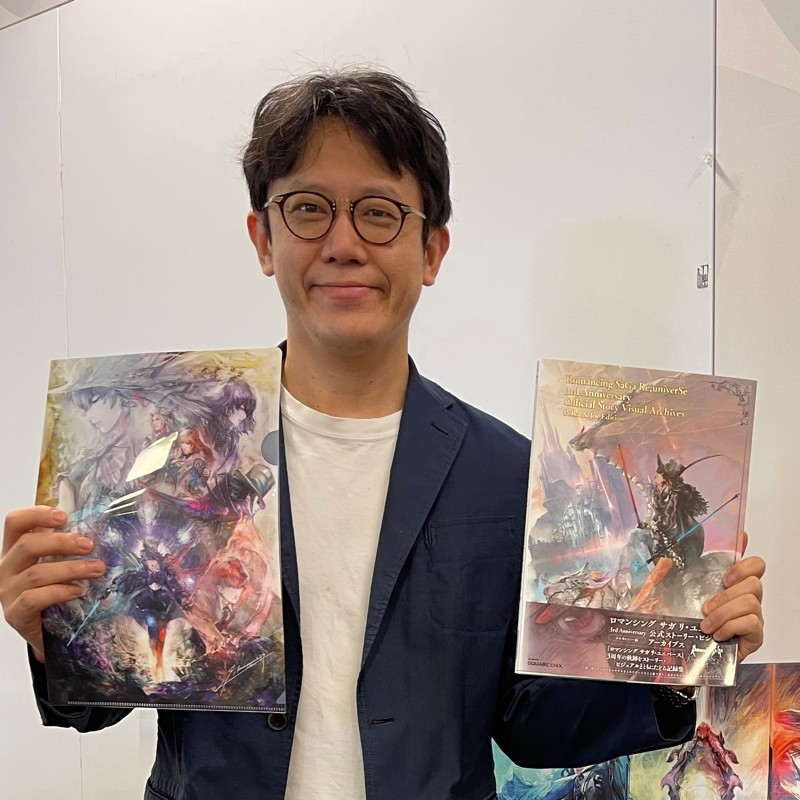
Masanori Ichikawa is a relative newcomer to the SaGa series (by way of showing up within the past few years), though he's been with SquareEnix (and Enix before that) for nearly 20 years at this point. He's on the list because, as producer, he's a big part of SaGa's recent resurgence. His name has been tied to pretty much any SaGa project that's been made since 2016 and he's actually since been declared the SaGa series producer. While Kawazu's passion for the SaGa franchise has kept the spark of hope alive for the series through some dark times for the franchise, Ichikawa is a major force in getting miracles like localized Romancing SaGa 2 and 3 and an actually completed SaGa Frontier 1 to actually happen. It stands a chance that the series is going to keep having good fortune as long as he's around, and it looks like he's going to be a lifer like Kawazu.
Key Shared Concepts
Use it or Lose it- SaGa games typically abandon the leveling structure that most RPGs maintain, instead going for a more freeform system where characters instead grow their abilities and stats based entirely around what they use. A character who fights a bunch with swords will get buffer and better at swords naturally. A character who chucks a lot of fireballs will get better at fire magic and will probably get a little smarter along the way. A character who splits time between both will become decent at both. It's a simple system that works really well when it works, though it admittedly can fail if not given proper care.
Go Discover Something!- SaGa games are very much about discovery. You are rarely given concrete directions for where to go, and often times you aren't even given a concrete quest to even have an inkling on having to go someplace to begin with. The worlds in most SaGa games are relatively open, with you being able to explore a significant amount of what there is to see based entirely around your ability to handle the challenges at each place. Offputting as this may sound, this often means that those NPCs who fill out each town that you likely never pay attention to in other games are now suddenly some of the most important resources in SaGa. Chatting up random NPCs you come will frequently guide you in new directions and, in some games, are actually key to causing new points of discovery to even show up on your world map. SaGa games demand that you actually put effort into learning about and exploring their worlds, and they are more than happy to reward you for doing so.
I Have No Idea What I'm Doing: By design, a lot of SaGa games are full of dense mechanics that are often not explained to you through tutorials, with there seldom being any tutorials to begin with. On top of SaGa games being meant for you to explore the world, you are meant to explore the mechanics. Since a lot of these games trend towards being on the shorter side compared to other RPGs, often times you might even have to start fresh. The recent remasters of Romancing SaGa 2 and 3 even bake this into the experience, by allowing you to restart the games but carry over your experience and items. This may sound daunting, but the experience of discovering the little intricacies of the SaGa games lead to a lot of rewarding joy that actually gives you a sense of accomplishment for the gains that you make.
A Decidedly Untolkein Experience: In a time when RPGs were still sticking to basic Tolkein ideas for the world, SaGa has always gone weird and interesting with its stories and characters, often times bridging the gap between fantasy, sci-fi, religious mysticism, and pop culture in a way that wasn't really seen at the time and is still pretty refreshingly unique to this day. From the very getgo, SaGa pits the player in a world set around a heavenly tower, where their party members include mutants and monsters who transform based on the meat you eat (and humans, I guess), and their foes include the four auspicious beasts of the Chinese constellation. The recently rereleased Romancing SaGa 3 demonstrates this beautifuly in how you can have a party that only includes a Super Hero, his chunky copy cat, a helpful vampire, a snowman, and a giant lobster man, all of whom manage to occupy a space in the world that genuinely makes sense.
Grind Smart, Not More: While a lot of RPGs want you to go out and grind in the world to make progress, SaGa games often discourage that. Be it through level scaling, limited encounters, or limiting leveling based on how strong you are in comparison to your enemies, SaGa games are games that rarely reward you brute forcing through leveling. Instead, you are encourage to learn the systems to play smart, with most challenging fights in the SaGa games having ways to beat them that don't rely on you being grossly overpowered.
It Means Life: Most, though not all, of the SaGa games feature the Life Points system or something similar, making it to where your characters can survive fatal blows. For most of the games with this system, LP is a way to ensure that your characters come back at full fighting strength every battle (meaning needing to heal your HP between battles is a thing of the past for a lot of these games). The balance for this system is that LP decreases as characters die and are hit when they are unconcsious. A character reaching 0 LP means they are often lost forever. Don't let this happen!
Unless you are playing Romancing SaGa 3 and are either trying to "kill" Charl in Muse's dream to bring an item back into the real world that normally can't exist outside of Dreams or are trying to get rid of the Bard. Either is fine.
No, You Don't Have To Hit Yourself To Get Stronger: Though they share a similar character building system, the much maligned (and incredibly bad) strategy in Final Fantasy 2 to beat up your own characters to build up their HP doesn't work in SaGa games (and didn't really actually work to your benefit in FF2 anyway). Please don't bring that baggage here.
A Little Bit of History:
Final Fantasy II (1988): Where It All Sorta Began

Look, I get what you are thinking, this is a thread about SaGa and here I am leading off with Final Fantasy II, but this is actually important! Having been a big part of the mechanical design of FF1, Akitoshi Kawazu was given the opportunity to play a bigger role in the design of FF2. Wanting to create something that was even more similar to his beloved tabletop RPGs, Kawazu helped guide FF2 towards something that, yeah, honestly does represent a lot more of the ttrpgs that got abandoned by JRPGs by including things like the password and key item systems and setting the world up to be a more continuous map that opened up based on how powerful you were. Obviously the elephant in the room is the execution of the game's stat system, itself heavily inspired by Chaosium's....um...Chaosium tabletop system that fueled games like Call of Cthulhu that were picking up popularity in Japan. FF2 doesn't really execute the system particularly well, being functionally broken in a lot of ways. Fans, especially in the west, point at this game as the black sheep of the series, often times labeling it as the worst in the series (it isn't) and a mistake. Square clearly didn't think so. While Final Fantasy obviously course corrected back hard with FF3 two years later, Square instead took the ideas of FF2 and spun it off into the veritable franchise we're going to be talking about here! As it stands, FF2 is a very misunderstood game and is definitely worth just as much of a reevaluation as a lot of the games we're getting into here. Just...maybe...play the remakes.
The Games
Makai Toushi SaGa/The Final Fantasy Legend (1989/1990)


Fresh off the development of FF2, Kawazu was given a basic concept by another coworker to turn into what would become his first game as director. As such, this game very much reflected Kawazu's experience designing a lot of the core ideas of FF2 but also FF1. In a way that blended ideas from both games, you create a party of characters from one of three core classes (Human, Monster, and Mutant/Esper) similar to FF1, but the development of those characters is actually different between classes. Humans level up more similarly to how they do in certain old RPGs (namely, to a point, Ultima) with your advancement as a human being based around purchasing upgrades to your stats and buying better gear. Mutants function like FF2 characters to a point, leveling up their stats based on what they use/do, though they also learned new abilities randomly. Monsters neither level nor do they equip items, instead gaining new forms (and thus more/less power and abilities) based on the meat of enemies they consume after battle. Each of the character classes have their quirks, but just about any combination can reasonably work once you start to pick apart those quirks and learn how the game functions (which, as noted, is a common expectation for the series).
The world itself shows up front that SaGa would be a series that broke a lot of norms for the genre. Instead of a typical fantasy world, SaGa was set against a sprawling heavenly tower that connected many different worlds together, all overseen by the Creator who lived atop the tower. The heroes start from the beginning of the tower and are tasked with climbing the tower so they can meet (and defeat) the Creator. Along the way, you'll often break off from ascending tower to explore the worlds connected along the way, several of which are beset by the four saint beasts of Chinese mythology.
SaGa 1's release is pretty important for a lot of reasons I noted prior. It's initial Japanese release was a pretty big point for both showing that Square was capable of doing more than just Final Fantasy, netting Square its first million seller. It was also an incredibly early release for the Game Boy, being one of the first twenty titles sold in the system's first year. Many other releases for the system that year were dramatically cut down experiences based on current popular titles (Mario Land and Castlevania were primary examples of this) or were based on vastly older and simpler games than what we were seeing on consoles around the time. SaGa was a deep and complex game that, smaller world aside, compared pretty favorably to its genre contemporaries. Similarly, when it came time to release Final Fantasy in the US the next year, SaGa would be rebranded under the Final Fantasy name as Final Fantasy Legend to provide a striking level of brand synergy that helped build up the Final Fantasy name while also giving us westerners our first taste of SaGa goodness. Even though it isn't a final fantasy game in truth (unlike Final Fantasy Adventure, which always had Final Fantasy branding to begin with), it's not exactly an unfair label given the developmental connection. Years later, after FF7 blew up and made the genre viable in the west and right when Pokemon was on the cusp of revitalizing interest in the aging Game Boy, Sunsoft would make the decision to license the publishing rights for this game and its two immediate sequels to reprint the game and strike while the iron was hot.

Should I Play It?: Yes!
Why Should I Play it: On top of being a historically important game, SaGa 1 is an extremely good game for its vintage. While the jank is absolutely there, especially with Mutant characters, the game is otherwise pretty easy to figure out the quirks and none of its quirks are that dramatically complicated. It's also a game that is readily available to find and can be played on a lot of Gameboy adjacent platforms. Finally, it's not a particularly long game, making it an easy game to breeze through, especially once you figure out enough of its quirks to speedrun the game (a full party of monsters will definitely make this feasible!).
How Important Is the Story: This is easily one of the lightest stories in the game, giving you a fairly simple main quest up front that never really gets deep itself, though individual scenarios you encounter along the way do actually get to be more fleshed out, culminating in an honestly depressing story unfolding when you reach the apocalyptic world haunted by Suzaku.
How Should I Play It: SaGa 1 was remade a couple times for other platforms, but the easiest way to play it is still honestly the original Gameboy version via the Switch SaGa Collection (which gives you the benefit of a speed toggle). That said, if you want to play it on original hardware, that is very much an option. The Sunsoft reissue made it to where this game is fairly easy and cheap to reacquire, and the long life of the gameboy (and the existence of things like the Gameboy Advance, the GBA Player, and the Super Gameboy) give you a lot of different and easy ways to play the game. You can track down the remakes if you wish, but do go into them knowing that you will be limited in playing the game in Japanese and will have a much harder time acquiring the hardware and software necessary to play the game.
What Should I Keep In Mind: SaGa 1 is a simple game compared to almost everything that follows it, but there are still some quirks to learn. First, unlike other games of the era, you can lose characters permanently. Every character has LP (Hearts) and can be brought back as long as they have them. You can buy more, but they are expensive. Second, Mutants can be powerful characters, but also gain a lot of their abilities randomly. Be ready to save and reload constantly (which is easy enough, because SaGa is an early JRPG that lets you save anywhere!)
SaGa 2/Final Fantasy Legend 2 (1990/1991/2009)
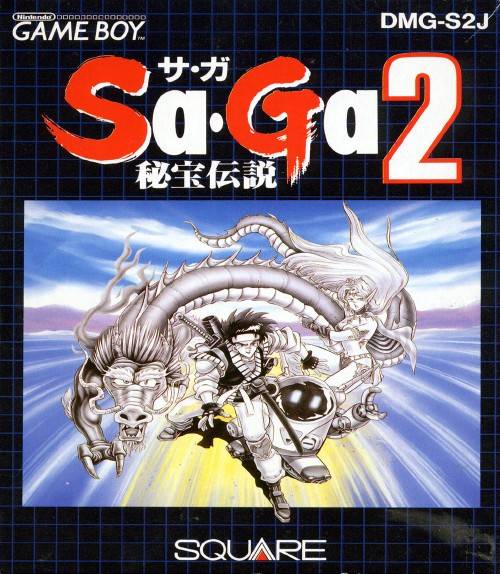
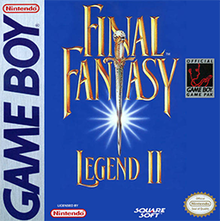

A year later, Kawazu and team brought us SaGa 2. There's not too terribly much for me to say here, because SaGa 2 is largely SaGa 1 but bigger and better. You have a lot of the same ideas of a party of generated characters traveling between worlds to eventually fight a godlike figure. It's the improvements that really matter and make the difference in going from SaGa 1, a genuinely good game, to what is honestly one of the finest JRPGs available on the Gameboy. The class system is overhauled from SaGa 1 to where Humans now function similarly to Mutants in having the FF2 style leveling, while a new playable class (Robots) now function like SaGa 1 style humans did. Monsters are further refined from what they did with many more transformation options. Also the game introduces the Magi system, a very early pass at what would become the Materia system in FF7 where you equip magic orbs to give yourself special abilities. On top of all the mechanical changes, the story, though similar in concept to SaGa 1, is vastly more in depth with what you experience, with named NPCs now joining you along your quest to save the world.
SaGa 2 continued in the first game's footsteps by taking the Final Fantasy Legends name in the west. Like SaGa 1, this western release saw a 1998 reissue to capitalize on the popularity of FF7 (and timed perfectly to capitalize on the subsequent success of Pokemon) Unlike SaGa 1, which saw a basic Wonderswan and Phone remake, SaGa 2 got a full scale remake on the DS. This remake was never released outside of Japan, but it did get a fan translation.


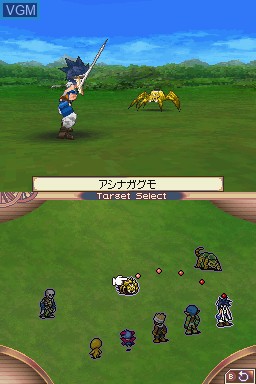
Should I Play It? 100% Absolutely. It's one of the best games on the platform, much less one of the best RPGs for the platform.
Why Should I Play It? If you are a fan of RPGs, you really ought to give it a shot. It's infinitely replayable, has an engaging story with a lot to discover, it's fun, combat is blindingly fast, and it has an incredible battle system.
How Important Is The Story? It has a similar concept to SaGa 1, but it has a much more involved story, with your "main character" (the first character you generate) having a personal quest to find their wayward father. Along the way, you'll recruit temporary characters who really flesh out the game's world.
How Should I Play It? You actually have three good options here. The original gameboy release is readily available and easy enough to play on different hardware as with SaGa 1. The DS remake is actually worth playing in its own right and, though it never got officially localized, it has a full fan translation that is easy enough to play on real hardware. Finally, the easiest way to play it is through the SaGa Collection on Switch.
What Should I Keep In Mind? Though the character building is heavily refined from what it was in SaGa 1 and you are given much more guidance than before, the game still does have a lot of randomness to how often character improvements happen and what those improvements are in the general moment. Also, it's worth noting that, instead of immediately getting a game over, Odin (yes, the norse god) will offer to save you from death at the promise of a duel at some point in the future. He will, in fact, keep saving you from losing all your progress...until the duel happens.
SaGa 3/Final Fantasy Legend 3 (1991/1993/2011)
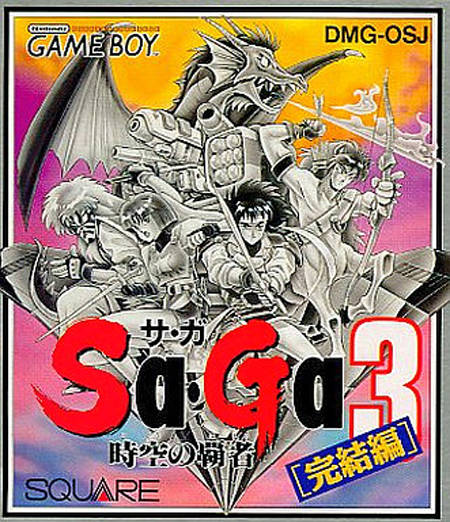


So while Kawazu and his series regulars would be spending time preparing for the leap to the Super Famicom, a ringer team would be brought in to round out the original Gameboy series of SaGa games in the form of SaGa 3. As this would be the team that would largely go on to make Final Fantasy Mystic Quest and Secret of Evermore, you can imagine that this game would be a little more basic than its bretheren, and you wouldn't necessarily be wrong. SaGa 3 does dump a lot of the series standards for something that plays more functionally like a traditional JRPG. With that said, the monster eating mechanic returns here, with your four main characters being able to either eat monster meat or apply robot parts to turn themselves into varying monsters, cyborgs, and robots similar to how the previous games handled Monster party members. Also bringing SaGa 3 more in line with traditional RPGs, you have a more straight forward adventure, with the game featuring a set of defined characters who go on a world saving quest through time to end a future world ending scenario. Along the way, you'll find parts to upgrade your time machine, giving you more freedom to explore the different time periods available to you and eventually expanding your time machine's capabilities to allow it to become a primary means of travel and even a mobile town.


-9.jpg)
Should I Play It? Yes
Why Should I Play It? SaGa 3 is honestly the easiest point of entry for the entire series. It's just traditional enough to make things approachable for players who aren't willing to invest as much time learning all the intricacies of a SaGa game, but it still has more than enough elements of the SaGa franchise to get you acclimated to playing the rest of the games.
How Important Is the Story? Unlike a lot of the rest of the games, SaGa 3 focuses on four core named characters with a rotating set of temporary fifth members, all on a pretty focused quest to save the future from a world ending catastrophie by traveling through time, eventually rebuilding a time machine and developing it to becoming your air transportation....yes, it's basically Chrono Trigger. A long the way, the recurring cast actually gets fairly fleshed out as you actually get to see some characters from different points of their life as you travel back and forth in time. It's actually neat!
How Should I Play It? Like with SaGa 2, you have three good options. Original GB carts are readily available and easy enough to play. The DS version was never officially released outside of Japan, but has a fan translation that is easy enough to play. Finally, there's the Switch SaGa collection that is the easiest way to play it today.
What Should I Keep In Mind? As the core mechanic to this game is the monster meat/robot parts system that was seen in the first two games, you'll be spending even more time here learning about how the different meats/parts interact with each other to power up/power down your party. As this is also a time traveling game, get used to the idea of exploring the same world from different points of time. Kawazu may not have been involved in this game, but his spirit of exploration is still very much present.
Romancing SaGa (1993/2005)


While the B-Team was working on SaGa 3, Kawazu and his A-Team (the K-Team?), newly joined by artist Tomomi Kobayashi, who will become a franchise mainstay from here on out, were hard at work on evolving the games to the console big leagues, which also necessitated a reboot to a new series name in the form of Romancing SaGa. Romancing SaGa 1 is the fruit of their labor and the result...is....interesting. Similar to its great grandfather in Final Fantasy II, it's got a bunch of good ideas, many of which would become reused in much better games, but the execution is definitely janky. You get eight characters to play through (with a very slight class system to customize how they start), you have the elements of the glimmer system that would become standard for the series once RS2 further solidifies how it works (and gives it a name), and other mechanics that would become standard for the series, like weapon levels, formations, and enemies being visible on the field. A lot of these features are in a much more basic and, in some cases, incomplete form than what we'll see in future games. With that said, there's a lot to like in this game. The variety in scenarios is really solid and the game goes hog wild with giving you reasons to poke around in the world.
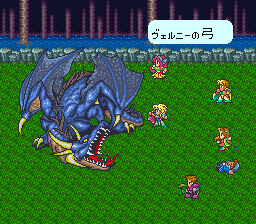


Should I Play It? Maybe play the original for just historical purposes. Do play the remake.
Why Should I Play It? If you have fond memories of SaGa Frontier, this is the game in the series that is the closest to that game. It's also a historically important title, being the first appearance of SaGa on home consoles. If you can get past the game's difficulty, there's a lot of fun things to be discovered, which is the point of all good SaGa games anyway.
How Important Is the Story? You have the options of picking from eight characters each with their own individual story archs, though sometimes intersecting, and their own set of available characters and areas to visit (though, again, sometimes intersecting). There's no mysterious 9th chapter with a character who ties everything together, so don't expect anything wild like that.
That's for Live A Live
How Should I Play It? If you must go the route of the SNES game, a fan translation exists. The PS2 game came towards the relatively later years of the system, but is not too hard to find. A PSN release of the remake for PS3 was planned, but apparently fell through the cracks. An HD remaster of the remake was released in December of 2022 for Android, iOS, Switch, PS4/5, and Steam. That's going to be your easiest way to play it now.
What Should I Keep In Mind? This game is hard and is, in part, a lot of the source of the series' reputation for its obtuseness. That said, it's not a bad game by any stretch. Once you figure out the quirks of the game, it does become fun but it has one of the biggest learning curves and also suffers from how a lot of ideas that would really define the series don't get really crystalized until the next game. The remake, Minstrel Song, will honestly end up transforming the game dramatically by dumping a good chunk of its original concepts and instead remaking it with a lot of concepts that came from later games.
Romancing SaGa 2 (1993/2017)

Much as SaGa 2 was a dramatic improvement over SaGa 1, Romancing SaGa 2 is a dramatic improvement over Romancing SaGa 1. Everything has been fine tuned for this game, with weapon levels being expanded upon to now reflect skill with groups of weapons and the ability to Glimmer (which now has a name) new skills being tied to your experience with a type of weapon rather than the individual weapons themselves. Formations have now expanded to a simple system of rows to now being a refreshingly complex mechanic that actually rewards you for experimenting with positioning your characters. The Life Point system returns and takes on its modern form as a more critical resource that will become a major part of the series moving forward, wherein having LP guarantees you will be restored back to full health at the end of every battle.
On top of all of the mechanical improvements, Romancing SaGa 2 has one of the most unique storytelling mechanics in the genre (one that largely only shows up again in one of its own sequels). Instead of telling a story of just one hero fighting evil and being done with it, Romancing SaGa 2 is a story of a family lineage, spanning hundreds of years, as you play the royal family governing an ever expanding empire. As such, the generational tale you experience is one that shows the development of the family (which changes dramatically from playthrough to playthrough) and the development of the empire, which itself is reflected by the actions you take throughout history. Furthermore, as this is a generational epic, as the royal family has sworn to topple the villainous Seven Heroes that plague the Empire of Avalon and its neighbors, the death of the emperor or emperess will never stop the family from coming back in the following generation, as each emperor and empress (until you get to the end game) will eventually die either in combat or by old age and will be replaced by their descendants over time, who will inherit the skills, magic, items, and otherwise progress of their ancestors.
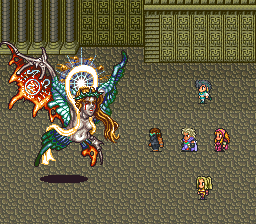

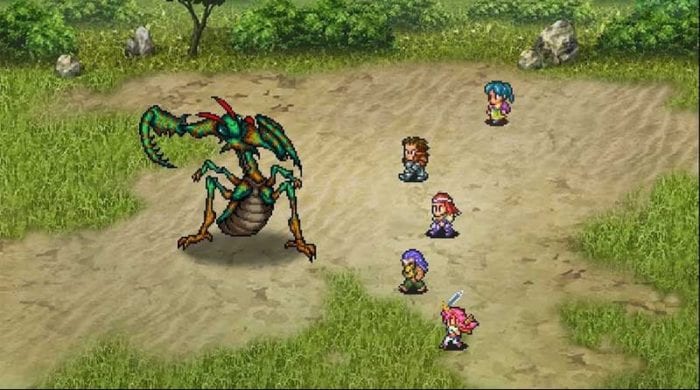

Should I Play It? Absolutely 100% do it.
Why Should I Play It? RS2 was one of the finest games on the platform, surpassed only really by its sequel and some of the biggest genre luminaries of its time. You are absolutely robbing yoursel for not playing it.
How Important Is the Story? While there are only a few named characters that you get at your command, and none of them stick around forever, this is a game that very much builds a very interesting story that plays out over many generations based on the actions that you take. It may disappoint people wanting a more dramatic story with defined characters, but it's very much the kind of game that rewards you for making your own story.
How Should I Play It? The original SNES version is somewhat accessible, though it was never released outside of Japan. This version was made available on the Wii and WiiU Virtual Consoles, but were also never released outside of Japan and the Wii version is now no longer purchaseable. A remaster was released globally on phones a few years ago and was released globaly on pretty much every current platform under the sun in late 2017. It's thus one of the easiest games in the series to play now.
What Should I Keep In Mind? Romancing SaGa 2 is a game where you will lose characters. Even if you play the game perfectly and never permanently lose a character to permadeath after losing all their LP, you are going to lose the characters you've developed every time there is a generational skip to a new Emperor/Empress. Thus, don't approach character building from the perspective you normally do with RPGs. Instead, remember that every new skill learned, every new spell researched, every new weapon and armor crafted, is something that will be passed down to future generations to benefit from. Your progress matters, even if your individual characters do not. Also, this is a game that actively punishes you for grinding. Only fight when you absolutely need to or if you are critically underleveled. Grinding too much will contribute to an interal counter that will eventually start scaling up enemies to match where you are expected to be after so many battles. Don't waste your time fighting trash mobs. You will only be hurting yourself. With that said, many dungeons will actually clear out monster encounters once you complete them, giving you an easy way to go back and explore dungeons and loot them once you've conquered their boss. Finally, you need to talk to townspeoples to find out about new quests and new areas. Don't get sloppy with exploring towns.
Romancing SaGa 3 (1995/2019)

Towards the end of Square's run on the SNES, Kawazu and co gave things one final shot for the venerable console in the form of Romancing SaGa 3. Once again, things have been further refined from RS2, with tweaks being made to how the underlying systems worked to make them flow even better than they did in the previous game. Glimmering, LP, Formations, and Magic/Weapon Skill Levels all return here. What's different this time around is that RS3 returns to the regular named characters of RS1, while also bringing back a group of selectable protagonists. Unlike RS1, these characters all largely experience the same general story, though they all witness things from different perspectives and have their own variations of how things go. Certain characters also have access to distinct mini-games that branch out into sidequests in their own right. There's not a lot for me to go over here. RS3 is a great game that builds on top of a great game before it and should absolutely be on your radar now that it is globally available on a number of platforms.
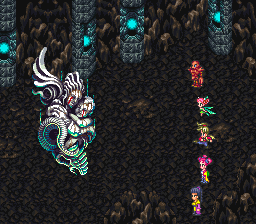
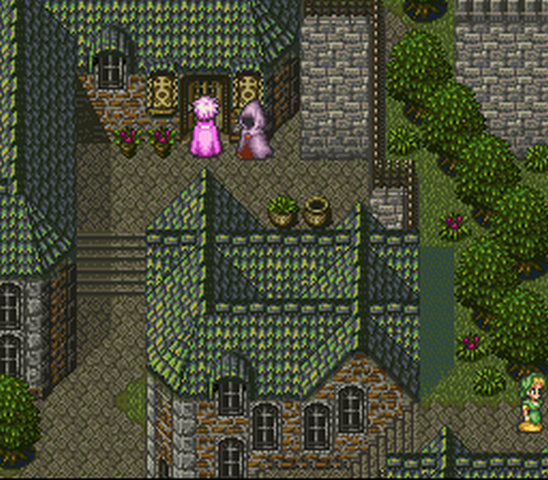

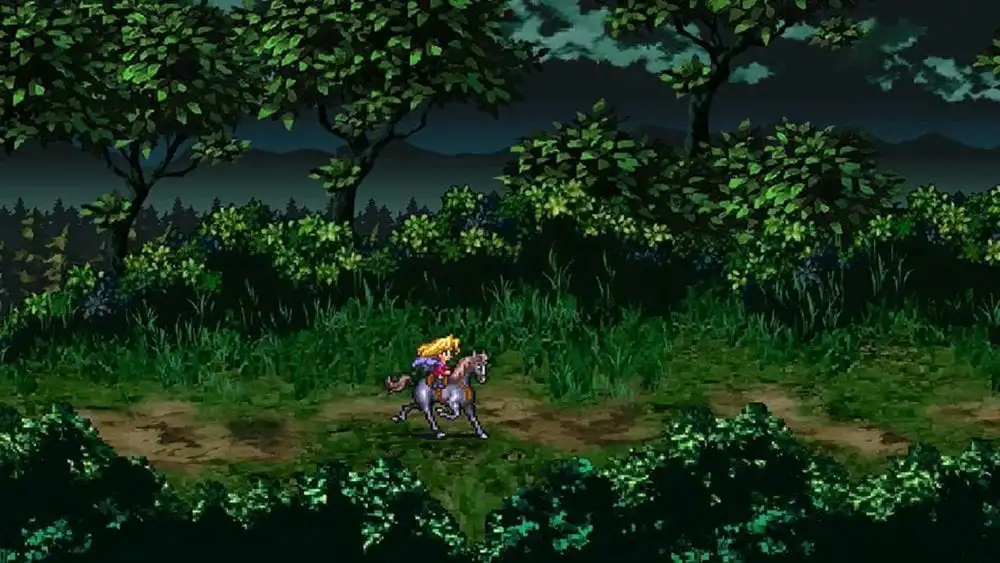
Should I Play It? Absolutely 100% Yes!
Why Should I Play It? Romancing SaGa 3 is one of the high points of the franchise. It covers just about every aesthetical and mechanical concept of SaGa that makes the series tink, while also keeping everything fairly approachable on the surface and only truly makes a lot of demands from you once you start to settle into the game more comfortably. It's easily one of the best games of its platform and is still great to experience today.
How Important Is the Story? Every character has a neat and defined opening that introduces you to everyone, and the game has a VERY neat premise with its world and what is going on in it, but you are largely going to be playing the game as a series of small vignettes until you actually get to the core story element of closing the Abyss Gates and dealing with the evil plot that's afoot. There's a lot to genuinely love about the game's writing, characters, and premise, but story itself is fairly light here.
How Should I Play It? Like RS2, you could go with the SNES version. Unlike RS2, a fan translation does exist (and was actually an early major fan translation), though it is infamously not quite complete. This version (sans fan translation, obviously) was available on the Wii and WiiU virtual consoles. More approachable is the modern remaster that released on virtually every major platform in 2019. That is probably the ideal way to play the game and even retains some important and beloved glitches.
What Should I Keep In Mind? RS3 is a very approachable game compared to RS2 and especially RS3, but it is one that still demands you learn its systems. Like RS2, it is critical that you explore towns and make sure you talk to everyone. This is how you will find out about quests and how you will unlock new areas on the world map to visit. Also, while you can fast travel to any known location, do not neglect to utilize the vast number of boats in the game's world, as this will be how you unlock locations that you won't hear about from NPCs. Finally, while the game isn't as harsh on you for grinding like RS2 is, you still should abstain from fighting needless battles.
SaGa Frontier (1997/1998)


With another console jump came another name reboot for the series, with SaGa Frontier becoming the new standard. SaGa Frontier 1 is notable for being Square's sophmore followup to Final Fantasy 7, which it's clear why being the game that followed that juggernaut would be pretty dang important. It's also the notable return of the series to the west, starting off a run of the series actually consistently seeing western releases up until the DS remakes.
SaGa Frontier 1 itself is a pretty straightforward game to talk about, even though it is just as dense and complex as its series brethren. Returning fully from Romancing SaGa 1 is the character scenario setup, where you play through each individual character scenario as contained campaigns within a shared world. Often times characters will overlap with each other, but each character's scenario is largely its own thing. SaGa Frontier 1 also brings back a lot of the general weirdness that had been lost since the Gameboy games, with Mutant (Mystic), Monster, and Robot characters being available to function as they did in the past. While most of the mechanics present are largely based around what was already refined in RS3, this game also plays up a new combo attack mechanics where characters can combine their attacks together to do significantly more damage. Again, not terribly much to say here, because the game is good and straightforward enough to speak for itself.

Should I Play It? Yes
Why Should I Play It? It's a historically important release, bringing SaGa back to the West after years of neglect while also being one of the first titles Square chose to release in the west immediately after Final Fantasy 7 to capitalize on its success. As such, it's one of the most well known games in the series. Even if it's not my personal favorite in the series, it is easy to understand why this game commands more nostalgia than almost any other game in the franchise. Plus, it's a really good game to boot, even if it's incredibly unfinished.
How Important Is the Story? This one is a matter of prioritization. If you want a grand overarching plot where everything ties together, this isn't it due to time and budget constraints cutting the chapter that would have done that. If you are fine with individual scenarios being fleshed out, this game has some scenarios that are pretty rich in plot and character building, while others aren't as much. It's a mixed bag if you are wanting story to be honest, but it absolutely has some great and interesting ideas with its characters and the things they do.
How Should I Play It? SaGa Frontier 1 was only ever a PS1 game, but you can find it incredibly easily as it was printed in reasonable quantities. In a major miracle, SaGa Frontier 1 got remaster on several modern platforms in 2021 that finally completed the game, along with providing a lot of very nice quality of life improvements (including the ability to carry over stats and equipment from scenario to scenario). That is undoubtedly the best (and easiest) way to play it.
What Should I Keep In Mind? Most immediately, it's important to remember that this is a tragically unfinished game. An eight and final chapter was planned around a character you can still recruit in game that would have tied a nice ribbon around your experiences playing the stories of the other characters, but this was ultimately cut before the game's release. The unfinished state also means there's a lot of other jank in the game, including some stories that seemingly end just as they are getting started. That said, what did make it into the final game is extremely good. Each of the seven characters have wildly different styles of play that all reflect different types of characters from throughout the series' history (with the Mutants, Monster, and Robot archetypes of the Gameboy games making their brief but triumphant return). As with other games in the series, you will also be spending a lot of time bouncing around the game's world. Update: While a lot of the game's original jank is still present, the modern remaster did actually try to include some of the old missing content, including mini-chapters that compose what would have been the basis of the lost 8th chapter based around Fuse.
SaGa Frontier 2 (1999/2000)

SaGa Frontier 2 is both a complicated and a simple game to talk about. Mechanically speaking, it is pretty straight forward, largely refining on what the previous few games had already done. The combat, character building, Life Points, and all that are pretty familiar here. Some new ideas, like 1v1 duels and a more fleshed out strategy mini-game, are present here, but the core gameplay of SF2 is pretty straight forward.
What is different and more complex here is the way the story is told. Taking a cue from Romancing SaGa 2, SaGa Frontier 2 is another generational epic, albeit one told over a dramatically shorter amount of time than RS2 did. Following, at least at the outset, the exploits of Gustav the Steel, outcast prince of the kingdom of Finney, and the adventures of Wil Knights, rookie Digger (a fancy way of saying treasure hunter), SF2 unfolds a story of betrayals, family, war, empire, and decline that starts from Gustav and Wil and eventually passes on to their successors. While it starts with the birth of Gustav and Wil's departure from his family home, this is a story that is also told non-linearly as the world map, in part, represents a timeline of events that become available for you to select and experience on a scenario by scenario basis. Characters will come and go from Gustav and Wil's lives and they themselves will eventually pass on the torch to other characters, making for a game that very frequently shifts perspectives. It's a story that also jumps around in time a lot, occasionally having you go back and experience events that happened in the past from where you were at, so you can better understand what's going on in the "present". Exhaustive as that may sound, the game does a great job of introducing characters and easing you into the generational shift.
Furthermore, SaGa Frontier 2 is a game of pure beauty. The visual style takes on a very water color painting style look to it and the music, provided by newcomer Masashi Hamauzu, goes the distance in painting the much more historically grounded world SF2 occupies.

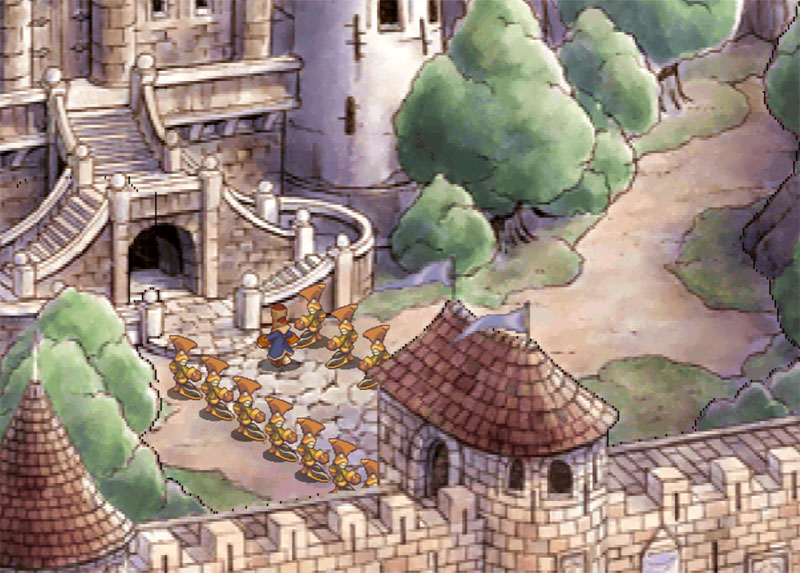
Should I Play It? Absolutely yes. 100% do it.
Why Should I Play It? The aesthetics alone make the game worth it. Instead of the random style of SF1, this game adopts a very gorgeous watercolor visual style for its background, set with detailed 2d sprites, all set to a stunning soundtrack by Masashi Hamauzu that mixes a lot of his traditional music background with the sort of Jazz fussion he adopted later in life. On top of the aesthetics, SF2 provides one of the most gripping but also uniquely told stories to come out of SquareEnix by telling the story of a whole continent and the people that lived in it over the generations from the perspectives of the elite royalty at the top and the adventerous people in the common folk. There's very few games like this, and it's all set with some of the most refined SaGa mechanics to date.
How Important Is the Story? This is easily one of the most story heavy games in the series, if not the most story heavy. While it is told non-linearly, SF2 really goes the distance in telling you a generational epic spanning kingdoms and family lineages.
How Should I Play It? SaGa Frontier 2 was only ever a PS1 game. While it didn't get as prominent of a western release following FF7 like SF1 did, it did get grandfathered in under the Summer of Square push despite being an early 2000 release in the West, which made it very available. This is the only legit way to play the game right now, but there are rumblings of new remasters that will likely include SF2.
What Should I Keep In Mind? Like Romancing SaGa 2, do not get attached to your characters. Until you get to the very final few chapters, you will not see your party ever locked down and will in fact not even have a consistent main character present. Next, though this game is definitely more guided and story heavy, you are absolutely still required to talk to NPCs to flesh out the game's world. Also keep in mind that, while you do get some leeway to explore the game non-linearly by focusing on the narrative of characters you like more, you are still intended to bounce around and experience stories in a vague order.
Unlimited SaGa (2002/2003)

Oh boy, here we go
Unlimited SaGa is weeeeeeiiiiiiiird
After a run of some really incredible games, Kawazu and co decided to really indulge on the series' inspiration in tabletop gaming to make a game that is honestly more a video game adaptation of a non-existant tabletop game than it is a standard JRPG. The result is something that really didn't gel with a lot of people at the time, and it really did a lot to tank the reputation of the franchise. In reality, it's honestly a fine game in its own right if you go into it with the mindset of playing it like the type of adventure/rpg-lite boardgames that are gaining in popularity today. Characters are represented by pewter figures, move around on board game maps, and do tabletop style skill checks at various points. Like Romancing SaGa 1 and SaGa Frontier 1, Unlimited SaGa presents multiple selectable characters with their own scenarios to complete. A lot of these scenarios play out as a series of board game runs where you move along a predefined board game map, fight enemies when you hit enemy spots, do skill checks when you find traps and other spots that require a skill check, and collect treasure when you land on treasure spots. Character growth is also handled in a dramatically weirder way than previous games, where you are given a random assortment of equipable stat/skill panels to equip to your character. You are only allowed an limited amount of these panels and you are never guaranteed better panels whenever you complete a mission. It can absolutely be a daunting system and Unlimited SaGa is especially limited in how much it explains to you up front. That said, if you are able to get past the incredible amount of jank and obtuseness, you'll find a game with some really great art, music, scenarios, and a pretty rewarding combat system once you get the hang of the spinner mechanic.
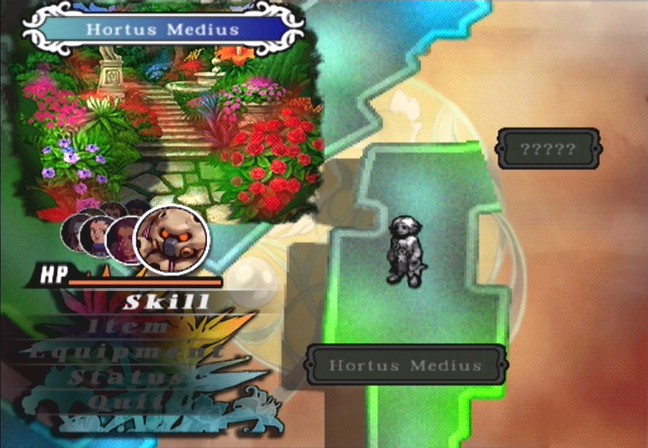
Should I Play It? Maybe, but only in the right mindset
Why Should I Play It? This game represents Kawazu trying to go as far as he could to turning SaGa into a tabletop gaming experience. Characters are represented as pewter wargaming pieces, you move along a boardgame like gride, and you spend a lot of time doing skill checks to pass encounters (using a spinner in place of dice rolling) rather than just having RPG battles. If this at all sounds appealing, then US might actually be the game for you. It's not for a lot of people, but there's a lot here to like in the right mindset.
How Important Is the Story? Unlimited SaGa harkens back to Romancing SaGa 1 and SaGa Frontier 1 in that you have a lot of characters with their own plots that sometimes intersect but there's not really a big plot at the center.
How Should I Play It? It got a PS2 release and is really common and cheap to find due to being sold as a $50 FFX-2 demo. There's been no subsequent release of the game, but recent rumblings make it sound like a remaster is possible.
What Should I Keep In Mind? Should you decide to play this game, you will either need to do a lot of experimentation to figure its mechanics out or you will need to do a lot of homework to suss out what its deal is. This game is one of the most complex games in the series and it gives you the least amount of footing to get started. This can be rewarding, but it can also be very frustrating. I do not fault for people bouncing off this game hard back in the day, even if I find it unfairly maligned. Also just keep in mind that the way you improve characters in this game is one that is fairly random, and can require you to repeat adventures so you can get better panels to equip.
SaGa Scarlet Grace (2016/2018/2019)
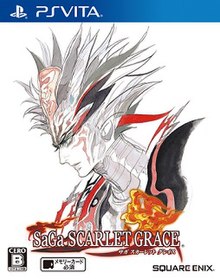
After almost 15 years with only remakes and mobile/web games happening for the series, SaGa Scarlet Grace originally showed up for the Vita in 2016 and was ported to PS4, Switch, PC, and Mobile in Japan last year under the updated name SaGa Scarlet Grace: Ambition. After a year long wait, these updated ports are hitting the global market in December of 2019. Blending elements of SaGa gameplay with some VN style story presentation, Scarlet Grace is a generally well regarded game that finally graced (;D) the west in after years of waiting.

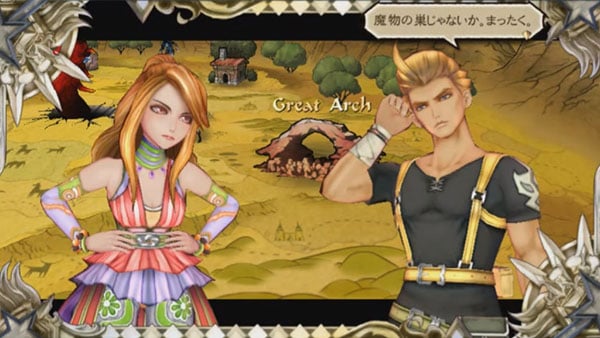
Should I Play It? Absolutely, 100% Yes!
Why Should I Play It? It's a brand new SaGa game, the first in years! It's also a very well regarded game in the fandom and is shockingly accessible.
How Important Is the Story? As with Romancing SaGa 1, SaGa Frontier 1, and Unlimited SaGa, Scarlet Grace has a number of separate storylines based around the selectable characters. Much of the game is split between story and fighting, so I'm happy to say that the story present is extremely good and fun.
How Should I Play It? Switch, PS4, Mobile, and Steam will be your best options for playing it, as those are available globally and are an improved version of the game. You can still go with the Vita original if you want, but you'll miss out on some improvements and your language options will be limited.
What Should I Keep In Mind? Combat is a bit different than it was in previous games, but not completely impenetrable. Every fight will generally let you know what the power level of your enemies are and what you'll gain from them lootwise
Romancing SaGa Re; UniverSe (2018/2020)

While there are other mobile games tied to the SaGa franchise, I would be remiss if I didn't at least highlight Re;UniverSe. As an incredibly popular mobile title, Re;UniverSe is likely part of why SquareEnix is fine with throwing more money behind the SaGa remasters than they seemingly do with other projects (so please stop asking about it anytime a SaGa remaster does more than the average Final Fantasy one) since this game is there to help bankroll things. As far as mobile gacha games go, this one is pretty fine. You get a lot of great Kobayashi art mixed in with a lot of new artists coming in to rethink classic characters and the gameplay is fairly fun for a gacha.

Should I Play It? Sure, though keep in mind it is a gacha.
Why Should I Play It? It helps to support the SaGa franchise, and it is fun here and there.
How Important Is the Story? A story exists in it, but it's a lot of excuses to get characters from different SaGas interacting with each other
How Should I Play It? It is readily available on iOS and Android
What Should I Keep In Mind? It is a gacha game
_________________________________________
WHERE TO START THE SERIES
So you have multiple good ways to start the series.
Final Fantasy Legend 3/SaGa 3 is the most straight forward of all the games in the franchise. It's a pretty acceptable bridge between regular JRPGs and SaGa. It is also fairly easy to obtain in its original GB incarnation and the DS version is easy enough to play with the fan translation. With that said, go into it understanding that it is a more traditional experience than other games in the series and you won't be 100% acclimated to the weirdness that the series has in store for you.
If you want to jump more into the series without being completely overwhelmed, SaGa Frontier 1 is your next best bet. Though it's not the best the series has to offer, it is the game that encompasses the most of what SaGa is while not being too bogged down in the really granular systems and secrets you have to unravel to really get good at any other typical SaGa game (which is why I would recommend it ahead of the vastly better RS2, 3, and SF2). The QoL improvements in the remaster also make it a lot more accessible.
Romancing SaGa 3 is also an acceptable starting point if you are limiting yourself to just current platforms. While there's still a ton of things to get lost in with it, it easily is the most approachable out of what's readily available on the market right now.
-------------------------------------------------------------------
The Aesthetics of SaGa
SaGa is a franchise that very much is elevated by its art and music, so here's a sampling of those to get your eyes and ears thirsting for more of that SaGa goodness.
Music:
Art:

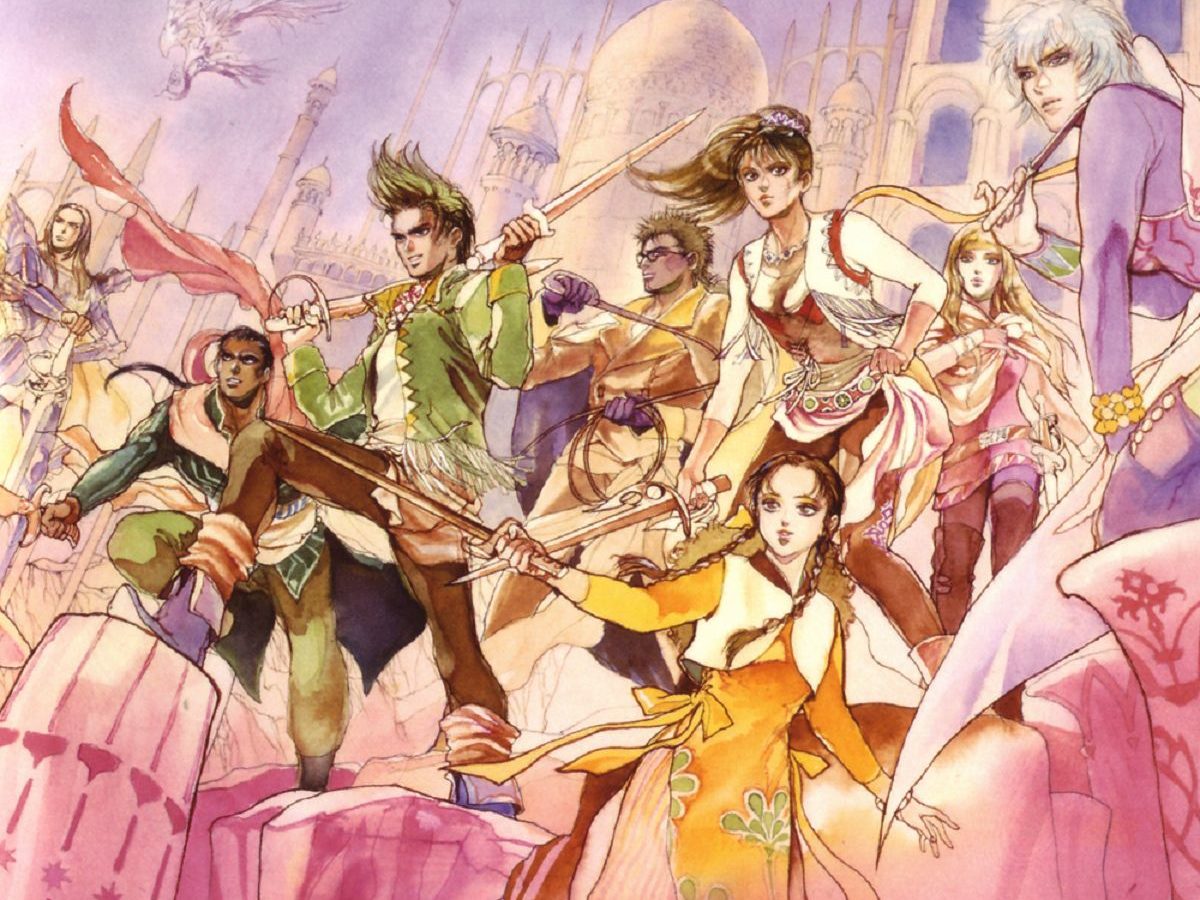

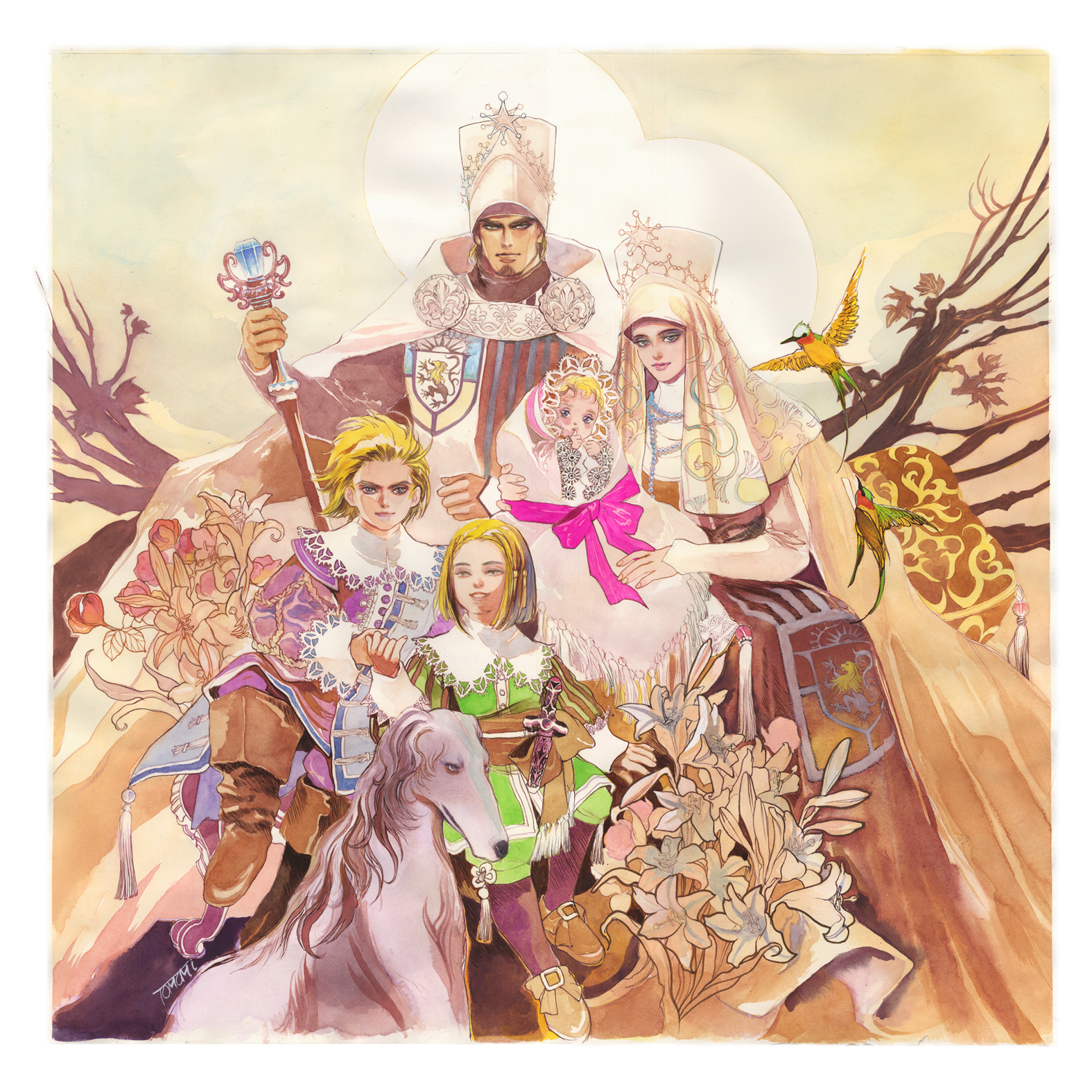

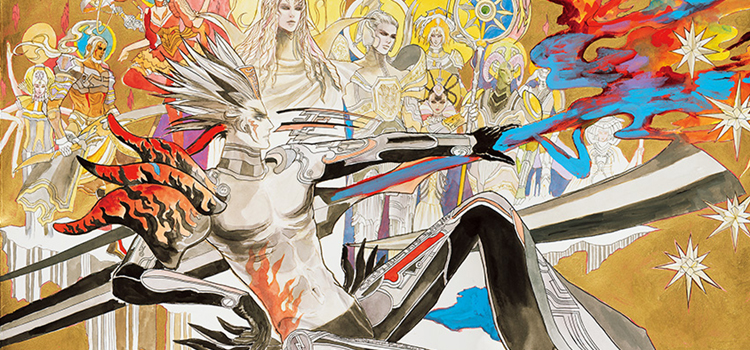
_____________________________________________________
The Legacy of SaGa: Adjacent Titles
As it would stand, SaGa's sense of discovery and exploration has led to other developers (including within SquareEnix itself) to explore similar ideas. The following are some notable titles that bare inspiration from SaGa
Live A Live (1994)

Though it only has a tenuous connection with SaGa, with its lead designer, Nobiyoki Inoue (who you might know more as the director of Mother 3) working on minor roles with SaGa 2 and Romancing SaGa prior to this, the influence of SaGa is pretty apparent up front in Live A Live. Taking Romancing SaGa's scenario system and SaGa's general penchant for doing more than basic fantasy, Live-A-Live puts you into a number of character focused scenarios that take place across time and space. Each scenario is effectively a mini-RPG in and of itself with a special gimmick that plays up the general genre. There's a Prehistoric chapter where your caveman character can sniff out enemies, a western chapter where you have to explore a frontier town and help set up traps to beat an outlaw gang that seeks to rob the villagers, a Sengoku-era ninja chapter that has stealth mechanics, a Sci-Fi chapter that goes almost without combat and almost a precursor to the walking simulators of today, and more. On top of the scenario system, Live-A-Live uses a very SaGa inspired character development system, while also employing SaGa's tendancy to have unsurfaced mechancs that can either help or hurt you (try not to run away much :P). Live A Live is definitely hidden gem in an already expansive library of classic SNES-era RPGs.
Treasure of the Rudras (1996)

Treasure of the Rudras itself doesn't seem particularly SaGa-like on the surface, what with a mostly standard combat system and leveling mechanics. Despite this, Kawazu was a designer for this game too and, even if this game seems more standard on the surface, it is anything but. Rudras brings over the scenario system from past SaGa games, allowing you to initially follow three different protagonists as they experience the final days of humanity. Each character has their own story, though their experiences and those of the people they encounter intertwine and split throughout the passage of time. You are also able to freely jump around between each character's scenario, with you not having to stick with a single character until you complete their scenario. Cool storytelling devices aside, this game is also notable for its experimental magic system, wherein you generate spells via typing in words into a spellbook and generating spells based on the symbols/letters used. There's actually a specific set of key words, suffixes, and prefixes to generate intended spells, but, of course, you can also cuss and say silly words to victory. This game also has some pretty great spritework and music. Lastly, it's also especially notable as being Square's last game on a Nintendo platform for many years.
Legend of Mana (1999/2000)

Legend of Mana may be a part of the Mana series, but this title truly has the influence of SaGa all over it. Of course, it'd be hard for it not to, with Kawazu producing and the game's design being led by SaGa vet Akihiko Matsui. Present, in a way, is the glimmer system from SaGa, but also, in general, Legend of Mana shows a lot of SaGa's penchant for experimentation. Bundled into an action RPG that's already good to its core is a number of systems ready to be explored, all set in a fairly open world where you are given pretty free reign to explore and complete scenarios as you wish, with the core campaign taking the backseat to the overall adventure. The original PS1 release was given a somewhat big enough print that it's not difficult to find, though there's recently been a remaster on PS4 and Switch. As such, it's pretty easy enough to play, and you definitely should.
Chrono Cross (1999/2000)
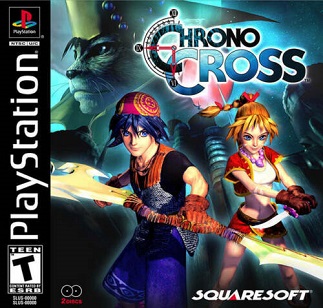
Chrono Cross abandons a lot of the simple mechanics of its predecessor and instead adopts a more experimental bent that not only incorporates SaGa's sense of exploration and anything goes attitude when it comes to character concepts, but it also incorporates the SaGa/FF2 style leveling system. The game's producer, Hiromichi Tanaka, was also a key programmer/designer for both Final Fantasy 2 and SaGa 2. The game hasn't seen a full rerelease since its original PS1 release, but you can purchase an emulated version of the PS1 version on PSN.
The Last Remnant (2008/2009/2018/2019)

Ramping up in games that are in the spirit of SaGa, The Last Remnant seems like an unrelated title at first, but it's just as SaGacious as a lot of the other games on this list. While the squad-based mechanics and strategic combat is new, the game features good ol' SaGa leveling and glimmering for building up your characters, the enemy scaling mechanics of the Romancing SaGa games, the general manner of exploring the world, and even a lot of the same general free-form take on tackling the many quests the game has to offer. To top it all off, Kawazu himself provided the initial concept for the scenario (bringing things full circle with how he came into the SaGa series to begin with). It was also directed by Hiroshi Takai, who was involved in numerous SaGa titles previously and is now directing Final Fantasy XVI, and its art comes courtesy of Unlimited SaGa's Yusuke Naora. It is certainly janky, but it's an incredible game when you take the time to figure out its quircks, just like any good SaGa should. It originally released on Xbox 360 and Steam (albeit slightly delayed) with a long delayed PS3 version eventually being cancelled. You can more easily find the remaster on PS4, Steam, and Switch. I strongly encourage people to give this game a shot.
The Legend of Legacy (2015/2016)
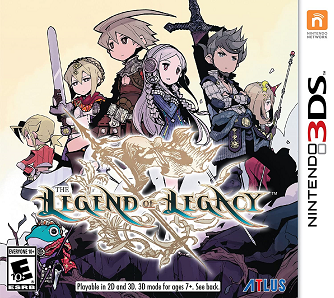
Moving on to SaGa successors that came from outside SquareEnix, Legend of Legacy represents the first of (currently) two attempts by Japanese publisher FuRyu to recapture the SaGa magic. FuRyu wasn't, of course, coming at this blind. Participating in the game's development were Toyomi Kobayashi and Masashi Hamauzu themselves, with the core game design being led by SaGa series vet Kyoji Kobayashi, among other SaGa vets. Legend of Legacy plays moderately into Romancing SaGa 3's setup of many selectable characters with their own introductions who all eventually funnel into the same core story. Also featured is SaGa's glimmering/skill system for learning new techniques and getting better with certain types of gear, along with a very basic form of the stat improvement system. As any good SaGa game should, Legend of Legacy is very much a game about exploration, with one of its most central NPCs in fact constantly instructing you to "Go discover something!" Legend of Legacy does have a bit of a mixed reputation. It's SaGa inspirations are pretty clear and its intentions are pretty pure, but the execution isn't entirely the best. Still, it's a solid foundation for what would come after it, and it's not a bad game in its own right. It's presently only a 3DS title, but that means it's easy enough to get and Atlus seems to put the North American version on sale pretty frequently. Nab it on a sale if you can. You probably won't regret it.
The Alliance Alive (2017/2018/2019)
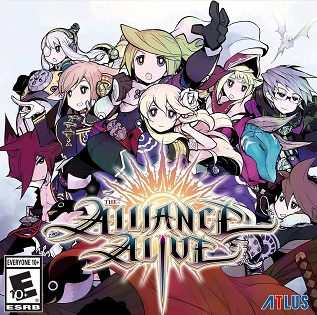

Much like how SaGa 2 and Romancing SaGa 2 dramatically improved on their immediate predecessors, Alliance Alive came along to build off of Legend of Legacy's foundation to create something better. Trading out Chrono Trigger's Masato Kato for friggin' Suikoden's Yoshitaka Murayama as writer, Alliance Alive brings about an even more realized world that manages to blend the themes of Suikoden with the general weirdness and sense of exploration from SaGa into a pretty compelling world with a lot of really neat characters. The game also mechanically improves upon TLoL's character building system to bring it even more in line with the typical SaGa game, while also incorporating a skill purchasing system to give you slightly more control on your character improvements. Formations also return to being much more key here. There's not as much to say here, because it's just a pretty solid game that does a lot to harken back to the old days of SaGa while finding some new improvements of its own. This game was originally released just on 3DS, but has since seen a remaster for Switch, PS4, and PC. It's easy enough to get those.
________________________________________________________
Go discover something new in the world of SaGa!
Last edited:

